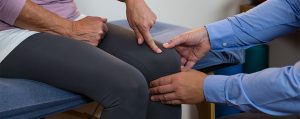3 Ways to Sleep Better with Shoulder Pain
Posted on by Brandon Bowers, PT, DPT, Astym Cert.
The importance of sleep cannot be overstated. Recent research has discovered links between poor sleep and “hypertension, obesity, type-2 diabetes, impaired immune functioning, cardiovascular disease, arrhythmias, mood disorders, neurodegeneration and dementia, and even loneliness.” The causes for poor sleep are vast, but as it relates to physical therapy, sometimes pain can be the cause. Have you ever had a night you just can’t seem to get comfortable because your neck, back, or shoulder hurts? Next thing you know, the alarm clock is ringing, and you’ve barely slept at all. You drag through the next day at work, aren’t productive, and then go home only to experience the same poor night of rest again. Let’s look at ways to improve sleep that is disrupted due to shoulder pain. Sleep position is the most important piece when it comes to shoulder pain. An improved sleep position can truly make the difference maker between a restful and unrestful slumber. The following sleep position modifications may help provide additional support to the arm/shoulder to reduce pain.
(more…)
Exercises to Improve your Golf Swing
Posted on by Owen Campbell, PT, DPT, OCS
Power or mobility? Range of motion or strength? As you begin to adapt your body for better performance on the golf course this spring, you need to figure out first what you need. This article will discuss the major stumbling blocks that I see the most with patients. These corrections are great for getting out of a chair the following day after a round of golf. They can also increase your power off the tee or on approach.
(more…)
Sever’s Disease in Gymnasts
Posted on by Tara Hackney, PT, DPT, OCS, KTTP
Many young kids that participate in sports can have complaints of pain in their heels. This is more common in children who are actively growing and those who are very active in running and jumping sports. Young gymnasts fall into this category, and they also practice and compete barefoot, which can lead to a higher risk of injury to the foot.
(more…)
What Is Hip Dysplasia?
Posted on by Paige Gibbens, PT, DPT
Isn’t hip dysplasia something dogs have? The short answer is yes, but humans can also have hip dysplasia. Hip dysplasia has become increasingly more prevalent over the past decade, as hip dysfunction can be a source of pain. So, what is it? A typical presentation of hip dysplasia can be when the acetabulum (the portion of the hip joint attached to the pelvis) does not fully cover the femoral head (the hip joint's ball). However, it may vary based on a variety of factors. Hip dysplasia can be diagnosed at birth, during childhood, or even as a young adult. Hip dysplasia is most common in females born from a first pregnancy and breech delivery.
(more…)
Ways Stress Can Affect Your Health
Posted on by Tanner Neuberger, PT, DPT, TDN Level 1
We all deal with stress from time to time, with some periods of our lives being more stressful than others. Everyone handles stress differently; some can cope with stress better than others, and some give in to the slightest bit of stress. Some use positive coping mechanisms like exercise and meditation, while others use negative coping mechanisms like substance use or other destructive behaviors. With all this increase in stress over recent years and decades, modern medicine has demonstrated within the past few years the effects stress can have on our physical and mental health, both long-term and short-term.
(more…)
How to Support a Family Member who Recently Had a Stroke
Posted on by Rebecca Pudvah PT, DPT, CSCS, OCS
In medical terms, a stroke is a loss of blood flow to part of the brain, which damages brain tissue. This impairment can occur in any part of the brain, which can have numerous effects, ranging from vision, auditory, speech, hearing, swallowing, balance, emotional control and/or motor control. A stroke is one of the few “invisible” conditions that affect a person in various ways. Below you will find the top four things you can do to help your loved one through their recovery process.
(more…)
Exercises to Relieve your Neck and Upper Back Tension
Posted on by Tony Matoska PT, DPT, CMPT
If you’re like the millions of Americans across the county, you may find yourself working at a job that requires an extensive amount of sitting, computer work, or meetings that don’t allow you to move and change positions as often as you need. According to the American Heart Association, over 80% of jobs are sedentary, requiring excessive sitting and not enough physical activity.1 Because of the pandemic, many of us are now working from home, which only increases the amount of time we spend sitting. Data shows that between 15 and 34% of desk workers will experience neck pain related to their job. Work-related neck pain is the leading cause of disability and absence from work.2
(more…)
How to Get the Most out of Your Workout
Posted on by J. Cory Silver, PT, DPT, VRT, CAFS, 3DMAPS
There are often multiple desires when it comes to exercising. We want to look better, get more toned, feel better physically or psychologically, or lose weight. It is possible to achieve many of these things simultaneously but having a goal and an exercise routine geared toward your wants and needs is the road map that can make you more successful. This blog will discuss strategies for goal setting and the SAID principle to help you choose activities to get the results you desire.
(more…)

